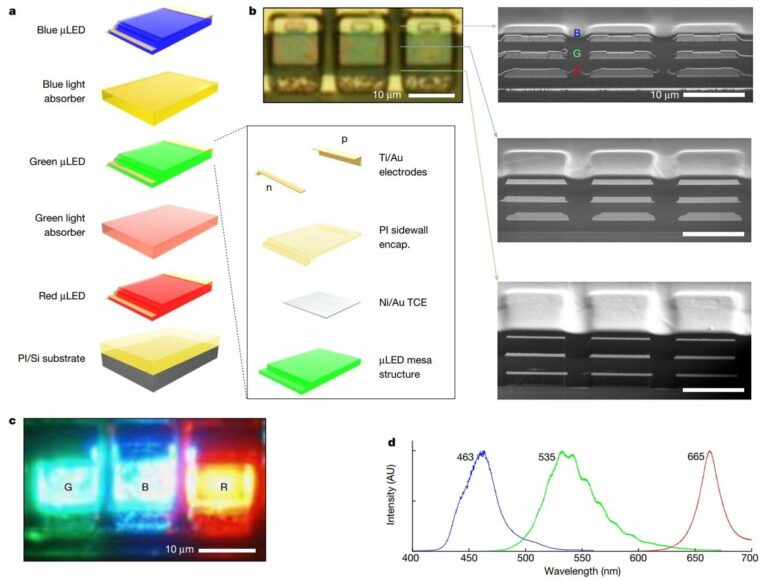Take apart your laptop screen, and at its heart you’ll find a plate patterned with pixels of red, green, and blue LEDs, arranged end to end like a meticulous Lite Brite display. When electrically powered, the LEDs together can produce every shade in the rainbow to generate full-color displays. Over the years, the size of individual pixels has shrunk, enabling many more of them to be packed into devices to produce sharper, higher-resolution digital displays.
But much like computer transistors, LEDs are reaching a limit to how small they can be while also performing effectively. This limit is especially noticeable in close-range displays such as augmented and virtual reality devices, where limited pixel density results in a “screen door effect” such that users perceive stripes in the space between pixels.
Now, MIT engineers have developed a new way to make sharper, defect-free displays. Instead of replacing red, green, and blue light-emitting diodes side by side in a horizontal patchwork, the team has invented a way to stack the diodes to create vertical, multicolored pixels.
Each stacked pixel can generate the full commercial range of colors and measures about 4 microns wide. The microscopic pixels, or “micro-LEDs,” can be packed to a density of 5,000 pixels per inch.
“This is the smallest micro-LED pixel, and the highest pixel density reported in the journals,” says Jeehwan Kim, associate professor of mechanical engineering at MIT. “We show that vertical pixellation is the way to go for higher-resolution displays in a smaller footprint.”
“For virtual reality, right now there is a limit to how real they can look,” adds Jiho Shin, a postdoc in Kim’s research group. “With our vertical micro-LEDs, you could have a completely immersive experience and wouldn’t be able to distinguish virtual from reality.”
The team’s results are published in the journal Nature. Kim and Shin’s co-authors include members of Kim’s lab, researchers around MIT, and collaborators from Georgia Tech Europe, Sejong University, and multiple universities in the U.S, France, and Korea.
Placing pixels
Today’s digital displays are lit through organic light-emitting diodes (OLEDs)—plastic diodes that emit light in response to an electric current. OLEDs are the leading digital display technology, but the diodes can degrade over time, resulting in permanent burn-in effects on screens. The technology is also reaching a limit to the size the diodes can be shrunk, limiting their sharpness and resolution.
For next-generation display technology, researchers are exploring inorganic micro-LEDs—diodes that are one-hundredth the size of conventional LEDs and are made from inorganic, single-crystalline semiconducting materials. Micro-LEDs could perform better, require less energy, and last longer than OLEDs.
But micro-LED fabrication requires extreme accuracy, as microscopic pixels of red, green, and blue need to first be grown separately on wafers, then precisely placed on a plate, in exact alignment with each other in order to properly reflect and produce various colors and shades. Achieving such microscopic precision is a difficult task, and entire devices need to be scrapped if pixels are found to be out of place.
“This pick-and-place fabrication is very likely to misalign pixels in a very small scale,” Kim says. “If you have a misalignment, you have to throw that material away, otherwise it could ruin a display.”
Color stack
The MIT team has come up with a potentially less wasteful way to fabricate micro-LEDs that doesn’t require precise, pixel-by-pixel alignment. The technique is an entirely different, vertical LED approach, in contrast to the conventional, horizontal pixel arrangement.
Kim’s group specializes in developing techniques to fabricate pure, ultrathin, high-performance membranes, with a view toward engineering smaller, thinner, more flexible and functional electronics. The team previously developed a method to grow and peel away perfect, two-dimensional, single-crystalline material from wafers of silicon and other surfaces—an approach they call 2D material-based layer transfer, or 2DLT.
In the current study, the researchers employed this same approach to grow ultrathin membranes of red, green, and blue LEDs. They then peeled the entire LED membranes away from their base wafers, and stacked them together to make a layer cake of red, green, and blue membranes. They could then carve the cake into patterns of tiny, vertical pixels, each as small as 4 microns wide.
“In conventional displays, each R, G, and B pixel is arranged laterally, which limits how small you can create each pixel,” Shin notes. “Because we are stacking all three pixels vertically, in theory we could reduce the pixel area by a third.”
As a demonstration, the team fabricated a vertical LED pixel, and showed that by altering the voltage applied to each of the pixel’s red, green, and blue membranes, they could produce various colors in a single pixel.
“If you have a higher current to red, and weaker to blue, the pixel would appear pink, and so on,” Shin says. “We’re able to create all the mixed colors, and our display can cover close to the commercial color space that’s available.”
The team plans to improve the operation of the vertical pixels. So far, they have shown they can stimulate an individual structure to produce the full spectrum of colors. They will work toward making an array of many vertical micro-LED pixels.
“You need a system to control 25 million LEDs separately,” Shin says. “Here, we’ve only partially demonstrated that. The active matrix operation is something we’ll need to further develop.”
“For now, we have shown to the community that we can grow, peel, and stack ultrathin LEDs,” Kim says. “This is the ultimate solution for small displays like smart watches and virtual reality devices, where you would want highly densified pixels to make lively, vivid images.”
More information:
Jeehwan Kim, Vertical full-colour micro-LEDs via 2D materials-based layer transfer, Nature (2023). DOI: 10.1038/s41586-022-05612-1. www.nature.com/articles/s41586-022-05612-1
Provided by
Massachusetts Institute of Technology
Citation:
Stacking LEDs instead of placing them side by side could enable fully immersive virtual reality displays (2023, February 1)



